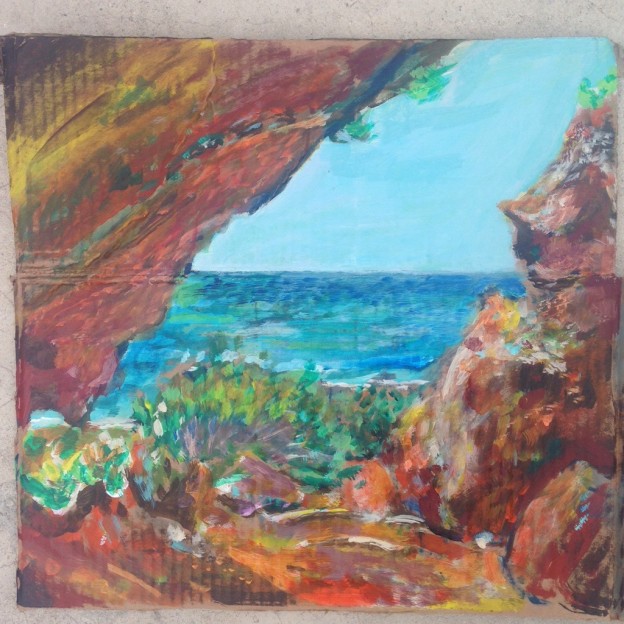Your cart is currently empty!

Painting inside landscape
I wanted to try painting with the acrylics on cardboard today. Up at 6am, I prepared the acrylics and the easel for a day out in the field. I met up with the students for breakfast and we first went to Sea View, a place I had not been before. Sophia introduced Sea View as an archeological site. We climbed to the top of a dune and saw many broken pieces of pottery sitting on the surface of the dune. Sea grape plants, among several other species, covered the dunes.
I learned an interesting trick that tells you if a particular shard of something is pottery or simply a rock: you lick it! Your tongue registers the smallest of sensations—the pores of the pottery draw in the moisture, causing a small suction sensation on the tip of your tongue. I am going to lick rocks and pottery alike in the future I imagine.
We walked over the edge of the dune system and saw an awesome sight. Many of the roots structures on the ocean facing side of the dune were exposed, draping in a sinewy fashion down the side of the 30 foot dune. Unfortunately that is a sign of ill-health. I don’t recall why the plants initially would die off, but the drought condition here seems pretty serious. The plants die, exposing the roots and the dune erodes from the constant ocean wind. This becomes a positive feedback loop. Since Barbuda is such a flat island, the dune systems are especially important to maintain.
From there we went to Two Foot Bay. I had been to this place before and remembered the spot I wanted to paint, so it took no time to decide where to set the easel up. We entered a cave right on the coast, up a fairly steep incline. This cave has a petroglyph that is unfortunately eroding fairly quickly. The cave is the perfect shelter from the ocean, it allows daylight in through several skylights. Of course it is better suited for smaller people – you can bump your head pretty hard on rock! I did, even though I remembered the pain from the last time I was in that cave. I can feel the bump from today on the top left side of my head, almost exactly above my left ear… a current sensation of the cave, where the cave gave voice to its hardness and that expression had an impact.
I set up the easel in the shade at the mouth of the cave, looking out at the ocean. I found my footing and got to work. The first thing I noticed is the absolute intensity of the bright blue sky. The rocks framed the sky, drawing it into further relief. I was working from an unprimed cardboard piece, so the color was almost an exact match for the rocks from the start. I had accidentally filled my water bottle with lemonade from one of the two coolers, so I had to dilute the paint with lemonade. Later I had wondered why ants were on the painting, but obviously the painting was sugar-coated! I sat there for several hours, working my way through the painting with only brief breaks. The sky could never be bright enough. No that’s too white, it is more colorful. No that is too dark. How many colors are in the sky? Why haven’t they invented a paint color that is an exact match yet? Probably because the sky is a different color from day-to-day. I should do a study. Take a photo of the sky every day from the same spot. Compare the blues. Average them out… but then it can never be the illuminated sky. It’s so bright.
Here I am, physically encased in the earth, looking out at the world as a part of the world. Of course I would choose this view—the practicality of spending several hours in the shade matched perfectly with a painterly expression along the phenomenological lines of being inside the landscape already. The cave opening mimics an eye shape in a sense, a slit. The painting becomes a reversal of Plato’s cave—instead of looking in at representations of the external world, I look out, with the cave and as a part of it.
And I felt a part of the cave, it’s artistic history, working my own ephemeral way. I painted on cardboard, conscious of the disposable nature of the work while thinking of the longevity of the old petroglyphs behind me. I joined with an unknown person across time and in place—sensing, responding, and expressing. I thought of other people who have used this cave. Did they have the junk with them that I did? I brought a lot in, but I brought a lot out. Did they spend a long time here? How different did their bodies feel while in this cave? I imagined the general sensations would be similar, yet I couldn’t help but wonder if the rocks were as hard for them.
Several lizards came to briefly investigate and carry on their way. The particularly gecko looking lizards move like snakes with legs. They are remarkably agile. I also saw a hermit crab scuttle across my view. I got up to look closer and the hermit crab returned to the cave opening it came from. It was about the size of a small grapefruit. I was impressed to see it up high in the cave, as I thought they were more likely to be at the sea. I later learned you can pin a hermit crab down by putting your finger on its shell and it will make a noise. They also are notorious for stealing shells from archeology sites. Cheeky Buggers.
Mural preparations at the school begin tomorrow.